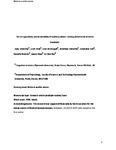The Recognizability and Localizability of Auditory Alarms: Setting Global Medical Device Standards
| dc.contributor.author | Edworthy, J | |
| dc.contributor.author | Reid, S | |
| dc.contributor.author | McDougall, S | |
| dc.contributor.author | Edworthy, Judy | |
| dc.contributor.author | Hall, S | |
| dc.contributor.author | Bennett, D | |
| dc.contributor.author | Khan, J | |
| dc.contributor.author | Pye, E | |
| dc.date.accessioned | 2017-06-27T08:39:50Z | |
| dc.date.available | 2017-06-27T08:39:50Z | |
| dc.date.issued | 2017-11-01 | |
| dc.identifier.issn | 0018-7208 | |
| dc.identifier.issn | 1547-8181 | |
| dc.identifier.other | 0 | |
| dc.identifier.uri | http://hdl.handle.net/10026.1/9551 | |
| dc.description.abstract |
<jats:sec><jats:title>Objective</jats:title><jats:p> Four sets of eight audible alarms matching the functions specified in IEC 60601-1-8 were designed using known principles from auditory cognition with the intention that they would be more recognizable and localizable than those currently specified in the standard. </jats:p></jats:sec><jats:sec><jats:title>Background</jats:title><jats:p> The audible alarms associated with IEC 60601-1-8, a global medical device standard, are known to be difficult to learn and retain, and there have been many calls to update them. There are known principles of design and cognition that might form the basis of more readily recognizable alarms. There is also scope for improvement in the localizability of the existing alarms. </jats:p></jats:sec><jats:sec><jats:title>Method</jats:title><jats:p> Four alternative sets of alarms matched to the functions specified in IEC 60601-1-8 were tested for recognizability and localizability and compared with the alarms currently specified in the standard. </jats:p></jats:sec><jats:sec><jats:title>Results</jats:title><jats:p> With a single exception, all prototype sets of alarms outperformed the current IEC set on both recognizability and localizability. Within the prototype sets, auditory icons were the most easily recognized, but the other sets, using word rhythms and simple acoustic metaphors, were also more easily recognized than the current alarms. With the exception of one set, all prototype sets were also easier to localize. </jats:p></jats:sec><jats:sec><jats:title>Conclusion</jats:title><jats:p> Known auditory cognition and perception principles were successfully applied to an existing audible alarm problem. </jats:p></jats:sec><jats:sec><jats:title>Application</jats:title><jats:p> This work constitutes the first (benchmarking) phase of replacing the alarms currently specified in the standard. The design principles used for each set demonstrate the relative ease with which different alarm types can be recognized and localized. </jats:p></jats:sec> | |
| dc.format.extent | 1108-1127 | |
| dc.format.medium | Print-Electronic | |
| dc.language | en | |
| dc.language.iso | en | |
| dc.publisher | SAGE Publications | |
| dc.subject | audition | |
| dc.subject | auditory displays | |
| dc.subject | learning | |
| dc.subject | medical device technologies | |
| dc.title | The Recognizability and Localizability of Auditory Alarms: Setting Global Medical Device Standards | |
| dc.type | journal-article | |
| dc.type | Journal Article | |
| dc.type | Research Support, Non-U.S. Gov't | |
| plymouth.author-url | https://www.webofscience.com/api/gateway?GWVersion=2&SrcApp=PARTNER_APP&SrcAuth=LinksAMR&KeyUT=WOS:000412490700007&DestLinkType=FullRecord&DestApp=ALL_WOS&UsrCustomerID=11bb513d99f797142bcfeffcc58ea008 | |
| plymouth.issue | 7 | |
| plymouth.volume | 59 | |
| plymouth.publication-status | Published | |
| plymouth.journal | Human Factors | |
| dc.identifier.doi | 10.1177/0018720817712004 | |
| plymouth.organisational-group | /Plymouth | |
| plymouth.organisational-group | /Plymouth/Faculty of Health | |
| plymouth.organisational-group | /Plymouth/Research Groups | |
| plymouth.organisational-group | /Plymouth/Research Groups/Centre for Brain, Cognition and Behaviour (CBCB) | |
| plymouth.organisational-group | /Plymouth/Research Groups/Centre for Brain, Cognition and Behaviour (CBCB)/Behaviour | |
| plymouth.organisational-group | /Plymouth/Users by role | |
| dc.publisher.place | United States | |
| dcterms.dateAccepted | 2017-04-15 | |
| dc.identifier.eissn | 1547-8181 | |
| dc.rights.embargoperiod | Not known | |
| rioxxterms.versionofrecord | 10.1177/0018720817712004 | |
| rioxxterms.licenseref.uri | http://www.rioxx.net/licenses/all-rights-reserved | |
| rioxxterms.licenseref.startdate | 2017-11-01 | |
| rioxxterms.type | Journal Article/Review |


